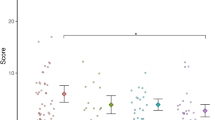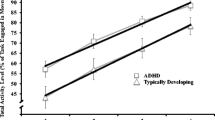Abstract
To assess the visuomotor attention ability in children with ADHD and controls and their response to placebo and Methylphenidate (MPH) treatment. 36 boys with ADHD and 36 age matched typical controls were administered the visuomotor attention test (VMAT) as a baseline and following a week of MPH(IR) or placebo administered to the study group, in a randomized crossover design. A significant difference between the study and control groups was found on several VMAT measures. No performance difference between ADHD dimensional sub-types was observed at the baseline assessment. Under MPH treatment a significant improvement in VMAT measures was observed and particularly in the combined and predominantly hyperactive (C\HI) type. The VMAT results obtained in the present study are consistent with previous findings. ADHD subtypes appear similarly short of visuomotor attention resources; a visuomotor test can be used in the assessment of gains derived from MPH treatment
Similar content being viewed by others
References
Goulardins JB, Rigoli D, Licari M, Piek JP, Hasue RH, Oosterlaan J et al (2015) Attention deficit hyperactivity disorder and developmental coordination disorder: two separate disorders or do they share a common etiology. J Behav Brain Res 292:484–492
Schoemaker MM, Ketelaars CEJ, van Zonneveld M, Minderaa RB, Mulder T (2005) Deficits in motor control processes involved in production of graphic movements of children with attention-deficit-hyperactivity disorder. J Dev Med Child Neurol 47(6):390–395
Langmaid RA, Papadopoulous N, Johnson BP, Phillips J, Rinehart NJ (2016) Movement scaling in children with ADHD-combined type. J Atten Disord 20:131–137
Pitcher TM, Piek JP, Barrett NC (2002) Timing and force control in boys with attention deficit hyperactivity disorder: Subtype differences and the effect of comorbid developmental coordination disorder. Hum Mov Sci 21:919–945
Kaiser ML, Schoemaker MM, Albaret JM, Geuze RH (2015) What is the evidence of impaired motor skills and motor control among children with attention deficit hyperactivity disorder (ADHD)? Systematic review of the literature. Res Dev Disabil 36:338–357
Hocherman S, Levy H (2000) The role of feedback in manual tracking of visual targets. Percept Mot Skills 90:1235–1248
Ehrlenspiel F, Wei K, Sternad D (2010) Open-loop, closed-loop and compensatory control: performance improvement under pressure in a rhythmic task. Exp Brain Res 201(4):729–741
Wolf K, Galeano Weber E, van den Bosch JJF, Volz S, Nöth U, Deichmann R et al (2018) Neurocognitive development of the resolution of selective visuo-spatial attention: functional MRI evidence from object tracking. Front Psychol 9:1106–1122
Greenhill L, Swanson J, Vitiello B, Davies M, Clevenger W, Wu M et al (2001) Impairment and deportment responses to different methylphenidate doses in children with ADHD: the MTA titration trial. J Am Acad Child Adolesc Psychiatry 40:180–187
Comer JS, Olfson M, Mojtabai R (2010) National trends in child and adolescent psychotropic polypharmacy in office-based practice, 1996–2007. J Am Acad Child Adolesc Psychiatry 49:1001–1010
American Academy of Pediatrics (2011) ADHD: clinical practice guideline for the diagnosis, evaluation, and treatment of attention-deficit/ hyperactivity disorder in children and adolescents. Pediatrics 128(5):1007–1022
Brossard-Racine M, Shevell M, Snider L, Bélanger SA, Majnemer A (2012) Motor skills of children newly diagnosed with attention deficit hyperactivity disorder prior to and following treatment with stimulant medication. Res Dev Disabil 33:2080–2087
Hocherman S, Moont R, Schwartz M (2004) Response selection and execution in patients with Parkinson's disease. Brain Res Cogn Brain Res 19:40–51
Tirosh E, Perets-Dubrovsky S, Davidovitch M, Hocherman S (2006) Visuomotor tracking related to attention-deficit hyperactivity disorder (ADHD). J Child Neurol 21:503–507
Tirosh E, Elhasid R, Kamah SC, Cohen A (1993) Predictive value of placebo methylphenidate. J Pediatr Neurol 99(2):131–133
Hasson R, Fine JG (2012) Gender differences among children with ADHD on continuous performance tests: a meta-analytic review. J Atten Disord 16:190–198
O'Brien JW, Dowell LR, Mostofsky SH, Denckla MB, Mahone EM (2010) Neuropsychological profile of executive function in girls with attention-deficit/hyperactivity disorder. Arch Clin Neuropsychol 25:656–670
Sonuga-Barke EJ, Coghill D, Markowitz JS, Swanson JM, Vandenberghe M, Hatch SJ (2007) Sex differences in the response of children with ADHD to once-daily formulations of methylphenidate. J Am Acad Child Adolesc Psychiatry 46:701–710
Wang LJ, Chen CK, Huang YS (2015) Gender differences in the behavioral symptoms and neuropsychological performance of patients with attention-deficit/hyperactivity disorder treated with methylphenidate: a two-year follow-up study. J Child Adolesc Psychopharmacol 25:501–508
American Psychiatric Association (APA) (1994) DSM-IV: diagnostic and statistical manual of mental disorders (4thed). American Psychiatric Association, Washington (DC)
Decker SL, McIntosh DE, Kelly AM, Nicholls SK, Dean RS (2001) Comorbidity among individuals classified with attention disorders. Int J Neurosci 110:43–54
Lahey BB, Pelham WE, Loney J, Lee SS, Willcutt E (2005) Instability of DSM IV subtypes of ADHD from preschool through elementary school. Arch Gen Psychiatry 62:695–702
Rodriguez A et al (2007) Do inattention and hyperactivity symptoms equal scholastic impairment? Evidence from three European cohorts. BMC Public Health 13:327–340
Goyette CH, Conners CK, Ulrich RF (1978) Normative data on revised conners parent and teacher rating scales. J Abnorm Child Psychol 6:221–236
Chang LY, Wang MY, Tsai PS (2016) Diagnostic accuracy of rating scales for attention-deficit/hyperactivity disorder: a meta-analysis. Pediatrics 137(3)
Bental B, Tirosh E (2008) The effects of methylphenidate on word decoding accuracy in boys with attention-deficit/hyperactivity disorder. J Clin Psychopharmacol 28:89–92
Hocherman S, Levin G, Giladi N, Youdim MBH (1998) Deprenyl monotherapy improves visuo-motor control in early Parkinsonism. J Neural Transm (Suppl 52):63–69
Giladi N, Honigman S, Hocherman S (1999) The effect of Deprenyl treatment on directional and velocity control of arm movement in patients with early stages of Parkinson's disease. Clin Neuropharmacol 22(1):54–59
Weiser M, Shneider-Beeri M, Nakash N, Brill N, Bawnik O, Reiss S et al (2000) Improvement in cognition associated with novel antipsychotic drugs: a direct drug effect or reduction of EPS? Schizophr Res 46:81–89
Lahey BB, Willcutt EG (2010) Predictive validity of a continuous alternative to nominal subtypes of attention-deficit/hyperactivity disorder for DSM–V. J Clin Child Adolesc Psychol 39:761–775
Grizenko N, Paci M, Joober R (2010) Is the inattentive subtype of ADHD different from the combined/hyperactive subtype? J Atten Disord 13:649–657
Cole WR, Mostofsky SH, Larson JCG, Denckla MB, Mahone EM (2008) Age-related changes in motor subtle signs among girls and boys with ADHD. Neurology 71:1514–1520
Allen R, Decker SL (2008) Utility of the bender visual-motor gestalt test second edition in the assessment of attention-deficit/hyperactivity disorder. Percept Mot Skills 107(3):663–675
Kim S, Chen S, Tannock R (2014) Visual function and color vision in adults with attention-deficit/hyperactivity disorder. J Optom 7:22–36
Türkan BN, Amado S, Ercan ES, Perçinel I (2016) Comparison of change detection performance and visual search patterns among children with/without ADHD: evidence from eye movements. Res Dev Disabil 49–50:205–215
Fuermaier ABM et al (2018) Perception in attention deficit hyperactivity disorder. Atten Defic Hyperact Disord 10(1):21–47
Hung-Yu L, Hsieh-Chun H, Posen L, Fu-Yuan H, Wen-Dien C, Kuo CL (2014) Auditory and visual attention performance in children with ADHD: the attentional deficiency of ADHD is modality specific. J Attention Disord 21:856–864
Nigg JT, Blaskey LG, Huang-Pollock CL, Rappley MD (2002) Neuropsychological executive functions and DSM-IVADHD subtypes. J Am Acad Child Adolesc Psychiatry 41:59–66
Egeland J, Ueland T, Johansen S (2012) Central processing energetic factors mediate impaired motor control in ADHD combined subtype but not in ADHD inattentive subtype. J Learn Disabil 45:361–370
Pitcher TM, Piek JP, Hay DA (2003) Fine and gross motor ability in males with ADHD. Dev Med Child Neurol 45:525–535
Mueller S, Costa A, Keeser D, Pogarell O, Berman A, Coates U et al (2014) The effects of methylphenidate on whole brain intrinsic functional connectivity. Hum Brain Mapp 35:5379–5388
Swanson JM, Wigal TL, Volkow ND (2011) Contrast of medical and nonmedical use of stimulant drugs, basis for the distinction, and risk of addiction: comment on Smith and Farah. Psychol Bull 137:742–748
Coghill DR, Seth S, Pedroso S, Usala T, Currie J, Gagliano A (2014) Effects of methylphenidate on cognitive functions in children and adolescents with attention-deficit/hyperactivity disorder: evidence from a systematic review and a meta-analysis. J Biol Psychiatry 76:603–615
Flapper BC, Houwen S, Schoemaker MM (2006) Fine motor skills and effects of methylphenidate in children with attention-deficit-hyperactivity disorder and developmental coordination disorder. Dev Med Child Neurol 48:165–169
Stray LL, Stray T, Iversen S, Ruud A, Ellertsen B (2009) Methylphenidate improves motor functions in children diagnosed with hyperkinetic disorder. Behav Brain Funct 5:21–33
Bart O, Daniel L, Dan O, Bar-Haim Y (2013) Influence of methylphenidate on motor performance and attention in children with developmental coordination disorder and attention deficit hyperactive disorder. Res Dev Disabil 34:1922–1927
Bedard AC, Martinussen R, Ickowicz A, Tannock R (2004) Methylphenidate improves visual-spatial memory in children with attention-deficit/hyperactivity disorder. J Am Acad Child Adolesc Psychiatry 43:260–268
Hale JB, Reddy LA, Semrud-Clikeman M, Hain LA, Whitaker J, Morley J et al (2011) Executive impairment determines ADHD medication response: implications for academic achievement. J Learn Disabil 44:196–212
Solanto MV, Gilbert SN, Raj A, Zhu J, Pope-Boyd S, Stepak B et al (2007) Neurocognitive functioning in AD/HD, predominantly inattentive and combined subtypes. J Abnorm Child Psychol 35:729–744
Baeyens D, Roeyers H, Walle JV (2006) Subtypes of attention- deficit/hyperactivity disorder (ADHD): distinct or related disorders across measurement levels. Child Psychiatry Hum Dev 36:403–417
Germano GD, Pinheiro FH, Okuda PM, Capellini SA (2013) Visual-motor perception in students with attention deficit with hyperactivity disorder. Codas 25:337–341
Funding
This research received no funding.
Author information
Authors and Affiliations
Corresponding author
Ethics declarations
Conflict of interest
The authors declare that they have no conflict of interest. The study was not supported by any grant or pharmaceutical company involvement.
Ethical Approval
All procedures performed in study were in accordance with the ethical standards of the Bnei-Zion medical Helsinki committee and with the 1964 Helsinki declaration and its later amendments or comparable ethical standards. The study was approved by the Board of Education, the Israeli Ministry of Education research committee.
Informed Consent
Informed consent was obtained from all individual participants included in the study.
Additional information
Publisher's Note
Springer Nature remains neutral with regard to jurisdictional claims in published maps and institutional affiliations.
Rights and permissions
About this article
Cite this article
Hadar, Y., Hocherman, S., Lamm, O. et al. The Visuo-Motor Attention Test in Boys with Attention Deficit Hyperactivity Disorder (ADHD): Methylphenidate—Placebo Randomized Controlled Trial. Child Psychiatry Hum Dev 52, 96–103 (2021). https://doi.org/10.1007/s10578-020-00993-8
Published:
Issue Date:
DOI: https://doi.org/10.1007/s10578-020-00993-8




